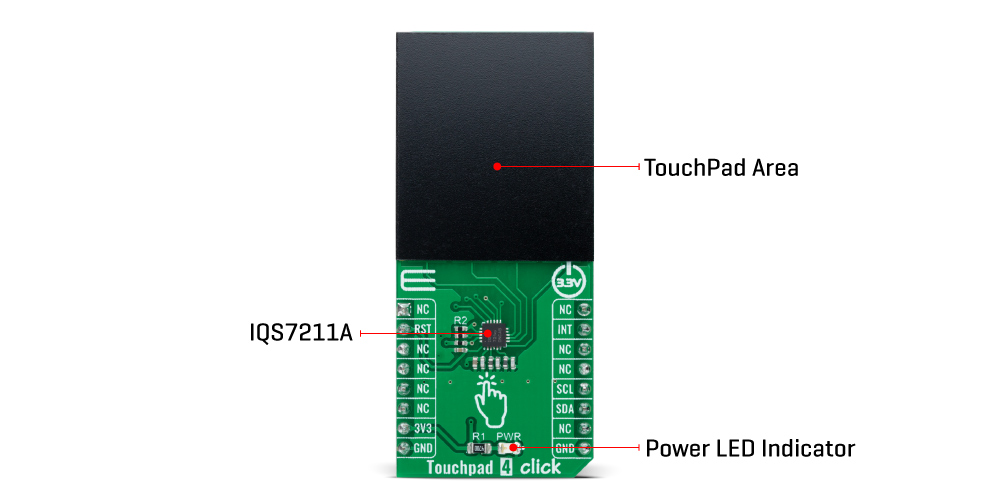OFF
GO LOCAL
| Company | Stock | Price |
|---|---|---|

MIKROE-4752
20 g
Status:
Touchpad 4 Click is a compact add-on board that easily integrates projected capacitive touch into user's applications. This board features the IQS7211A, a tiny capacitive touch controller from Azoteq. A low-power dedicated wake-up touch controller launches a complete touchscreen sensing solution with a 25.4 x 29mm trackpad dimension, best-in-class sensitivity, and power consumption. It is characterized by embedded gesture engine recognition for simple gestures (tap, swipes, hold) and built-in noise detection and filtering. This Click board™ is suitable for human-machine interfaces, keypad or scrolling functions, single-finger gesture-based interfaces, and more.
Touchpad 4 Click is supported by a mikroSDK compliant library, which includes functions that simplify software development. This Click board™ comes as a fully tested product, ready to be used on a system equipped with the mikroBUS™ socket.
This product is no longer in stock
Availability date:
OFF
| Company | Stock | Price |
|---|---|---|

Touchpad 4 Click as its foundation uses the IQS7211A, a tiny trackpad controller designed for multitouch applications using a projected capacitance touch panel from Azoteq. The IQS7211A is part of Azoteq’s latest range of ProxFusion combination sensors, a multi-sensor technology that offers combinations of capacitive sensing, Hall-effect, inductive, and temperature sensing on a single integrated circuit. It allows users to control a trackpad of up to 32-channels and offers high resolution and fast response, low power consumption, and long-term activation supported by environmental tracking. It is also characterized by embedded gesture engine recognition for simple gestures (tap, swipes, hold) and built-in noise detection and filtering.

On the Touchpad 4 Click front side, there is a clearly defined field that represents a touchpad area. This area is a matrix of conductive electrodes on the PCB, electrically isolated from each other, arranged as rows and columns of X and Y. An electrode consists of multiple diamond-shaped elements, each connected to the next with a conductive neck.
The controller uses the principle of projected capacitance charge transfer on the touchpad area. When a conductive object such as a human finger approaches the sense plate, it will decrease the detected capacitance. Observing the measured results at various sensing points on the touchpad area enables the controller to determine proximity/hover detection and contact (touch) detection on all channels and accurately determine the coordinates on the touch area.
Touchpad 4 Click communicates with MCU using a standard I2C 2-Wire interface, with a clock frequency up to 1MHz in the Fast Mode. An additional ready signal, routed on the INT pin of the mikroBUS™ socket, is added, which indicates when the communication window is available. Thus, it is optimal for the response rate to use the INT pin as a communication trigger. Alongside this pin, this Click board™ has a Reset feature routed to the RST pin on the mikroBUS™ socket, which with a low logic level puts the module into a Reset state, and with a high level operates module normally.
This Click board™ can be operated only with a 3.3V logic voltage level. The board must perform appropriate logic voltage level conversion before use with MCUs with different logic levels. However, the Click board™ comes equipped with a library containing functions and an example code that can be used, as a reference, for further development.
Type
Capacitive
Applications
Can be used for human-machine interfaces, keypad or scrolling functions, single-finger gesture-based interfaces, and more
On-board modules
IQS7211A - tiny trackpad controller designed for multitouch applications using a projected capacitance touch panel from Azoteq
Key Features
Low power consumption, high resolution, fast response, long-term activation supported by environmental tracking, embedded gesture engine recognition for simple gestures (tap, swipes, hold), and more
Interface
I2C
Feature
No ClickID
Compatibility
mikroBUS™
Click board size
L (57.15 x 25.4 mm)
Input Voltage
3.3V
This table shows how the pinout on Touchpad 4 Click corresponds to the pinout on the mikroBUS™ socket (the latter shown in the two middle columns).
| Label | Name | Default | Description |
|---|---|---|---|
| LD1 | PWR | - | Power LED Indicator |
| Description | Min | Typ | Max | Unit |
|---|---|---|---|---|
| Supply Voltage | - | 3.3 | - | V |
| Active Mode Current Consumption | - | 1.4 | - | mA |
| Operating Temperature Range | -40 | +25 | +85 | °C |
We provide a library for the Touchpad 4 Click as well as a demo application (example), developed using MIKROE compilers. The demo can run on all the main MIKROE development boards.
Package can be downloaded/installed directly from NECTO Studio Package Manager (recommended), downloaded from our LibStock™ or found on MIKROE github account.
Library Description
This library contains API for Touchpad 4 Click driver.
Key functions
touchpad4_reset Reset function.
touchpad4_get_touch Read touch informations.
touchpad_get_channels Read channel information.
Example Description
This example showcases ability of the device to read touch coordinates, active/inactive channels, and gesture informations.
void application_task ( void )
{
if ( !touchpad4_get_ready( &touchpad4 ) )
{
switch ( example_selector )
{
case TOUCHPAD4_EXAMPLE_TOUCH:
{
touchpad4_touch_reading( );
break;
}
case TOUCHPAD4_EXAMPLE_CHANNEL:
{
touchpad4_channel_reading( );
break;
}
case TOUCHPAD4_EXAMPLE_GESTURE:
{
touchpad4_gesture_reading( );
break;
}
default:
{
log_error( &logger, " Select Example" );
break;
}
}
}
}
The full application code, and ready to use projects can be installed directly from NECTO Studio Package Manager (recommended), downloaded from our LibStock™ or found on MIKROE github account.
Other MIKROE Libraries used in the example:
Additional notes and informations
Depending on the development board you are using, you may need USB UART click, USB UART 2 Click or RS232 Click to connect to your PC, for development systems with no UART to USB interface available on the board. UART terminal is available in all MIKROE compilers.
This Click board™ is supported with mikroSDK - MIKROE Software Development Kit. To ensure proper operation of mikroSDK compliant Click board™ demo applications, mikroSDK should be downloaded from the LibStock and installed for the compiler you are using.
For more information about mikroSDK, visit the official page.
NOTE: Please be advised that any peripheral devices or accessories shown connected to the Click board™ are not included in the package. Check their availability in our shop or in the YMAN section below.